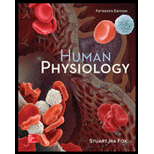
Human Physiology
15th Edition
ISBN: 9781259864629
Author: Fox, Stuart Ira
Publisher: Mcgraw-hill Education,
expand_more
expand_more
format_list_bulleted
Question
Chapter 19, Problem 36RA
Summary Introduction
To review:
The following:
1. The symptoms of overdose of insulin in a person with type 1 diabetes mellitus.
2. The treatment to adjust the blood glucose in such a case.
Introduction:
Insulin regulates the blood glucose level by lowering down the raised glucose concentration.This occurs by stimulation of the liver and skeletal muscles for the uptake of glucose from the blood plasma. Glucagon hormone serves to raise the plasma glucose concentration in the body.
Expert Solution & Answer
Want to see the full answer?
Check out a sample textbook solution
Students have asked these similar questions
help tutor please
Q8. A researcher wants to study the effectiveness of a pill intended to reduce stomach heartburn in pregnant
women. The researcher chooses randomly 400 women to participate in this experiment for 9 months of their
pregnancy period. They all need to have the same diet. The researcher designs two groups of 200 participants:
One group take the real medication intended to reduce heartburn, while the other group take placebo
medication. In this study what are:
Independent variable:
Dependent variable:
Control variable:
Experimental group: "
Control group:
If the participants do not know who is consuming the real pills and who is consuming the sugar pills.
This study is
It happens that 40% of the participants do not find the treatment helpful and drop out after 6 months.
The researcher throws out the data from subjects that drop out. What type of bias is there in this study?
If the company who makes the medication funds this research, what type of bias might exist in this
research work?
How do I determine the inhertiance pattern from the pedigree diagram?
Chapter 19 Solutions
Human Physiology
Ch. 19 - Explain how the metabolic rate is influenced by...Ch. 19 - Prob. 2aCPCh. 19 - Prob. 2bCPCh. 19 - Prob. 3CPCh. 19 - Distinguish between the energy reserves and...Ch. 19 - Prob. 5CPCh. 19 - Identify the brain regions involved in hunger and...Ch. 19 - Prob. 7CPCh. 19 - Describe how the secretions of insulin and...Ch. 19 - Prob. 8bCP
Ch. 19 - Define the following terms: glycogenolysis,...Ch. 19 - Prob. 9CPCh. 19 - Prob. 10aCPCh. 19 - Prob. 10bCPCh. 19 - Explain the meaning of the terms insulin...Ch. 19 - Prob. 12aCPCh. 19 - Prob. 12bCPCh. 19 - Prob. 13aCPCh. 19 - Prob. 13bCPCh. 19 - Describe the mechanisms by which the secretion of...Ch. 19 - Prob. 15aCPCh. 19 - Prob. 15bCPCh. 19 - Prob. 15cCPCh. 19 - ln questions 1-5, match the item to the correct...Ch. 19 - Prob. 2RACh. 19 - Prob. 3RACh. 19 - Prob. 4RACh. 19 - Prob. 5RACh. 19 - Prob. 6RACh. 19 - Prob. 7RACh. 19 - Prob. 8RACh. 19 - Prob. 9RACh. 19 - The increased intestinal absorption of calcium is...Ch. 19 - Prob. 11RACh. 19 - Prob. 12RACh. 19 - Prob. 13RACh. 19 - Prob. 14RACh. 19 - Prob. 15RACh. 19 - Prob. 16RACh. 19 - Prob. 17RACh. 19 - Prob. 18RACh. 19 - Prob. 19RACh. 19 - Prob. 20RACh. 19 - Prob. 21RACh. 19 - Prob. 22RACh. 19 - Prob. 23RACh. 19 - Prob. 24RACh. 19 - Prob. 25RACh. 19 - Prob. 26RACh. 19 - Prob. 27RACh. 19 - Describe the conditions of gigantism, acromegaly,...Ch. 19 - Describe how hormones secreted by the...Ch. 19 - Prob. 30RACh. 19 - Prob. 31RACh. 19 - Prob. 32RACh. 19 - Prob. 33RACh. 19 - Prob. 34RACh. 19 - Prob. 35RACh. 19 - Prob. 36RACh. 19 - Prob. 37RACh. 19 - Prob. 38RACh. 19 - Prob. 39RACh. 19 - Prob. 40RACh. 19 - Prob. 41RACh. 19 - Prob. 42RACh. 19 - Prob. 43RA
Knowledge Booster
Similar questions
- 22. Which of the following mutant proteins is expected to have a dominant negative effect when over- expressed in normal cells? a. mutant PI3-kinase that lacks the SH2 domain but retains the kinase function b. mutant Grb2 protein that cannot bind to RTK c. mutant RTK that lacks the extracellular domain d. mutant PDK that has the PH domain but lost the kinase function e. all of the abovearrow_forwardWhat is the label ?arrow_forwardCan you described the image? Can you explain the question as well their answer and how to get to an answer to an problem like this?arrow_forward
- Describe the principle of homeostasis.arrow_forwardExplain how the hormones of the glands listed below travel around the body to target organs and tissues : Pituitary gland Hypothalamus Thyroid Parathyroid Adrenal Pineal Pancreas(islets of langerhans) Gonads (testes and ovaries) Placentaarrow_forwardWhat are the functions of the hormones produced in the glands listed below: Pituitary gland Hypothalamus Thyroid Parathyroid Adrenal Pineal Pancreas(islets of langerhans) Gonads (testes and ovaries) Placentaarrow_forward
arrow_back_ios
SEE MORE QUESTIONS
arrow_forward_ios
Recommended textbooks for you
 Human Physiology: From Cells to Systems (MindTap ...BiologyISBN:9781285866932Author:Lauralee SherwoodPublisher:Cengage Learning
Human Physiology: From Cells to Systems (MindTap ...BiologyISBN:9781285866932Author:Lauralee SherwoodPublisher:Cengage Learning Comprehensive Medical Assisting: Administrative a...NursingISBN:9781305964792Author:Wilburta Q. Lindh, Carol D. Tamparo, Barbara M. Dahl, Julie Morris, Cindy CorreaPublisher:Cengage Learning
Comprehensive Medical Assisting: Administrative a...NursingISBN:9781305964792Author:Wilburta Q. Lindh, Carol D. Tamparo, Barbara M. Dahl, Julie Morris, Cindy CorreaPublisher:Cengage Learning



Human Physiology: From Cells to Systems (MindTap ...
Biology
ISBN:9781285866932
Author:Lauralee Sherwood
Publisher:Cengage Learning


Comprehensive Medical Assisting: Administrative a...
Nursing
ISBN:9781305964792
Author:Wilburta Q. Lindh, Carol D. Tamparo, Barbara M. Dahl, Julie Morris, Cindy Correa
Publisher:Cengage Learning
